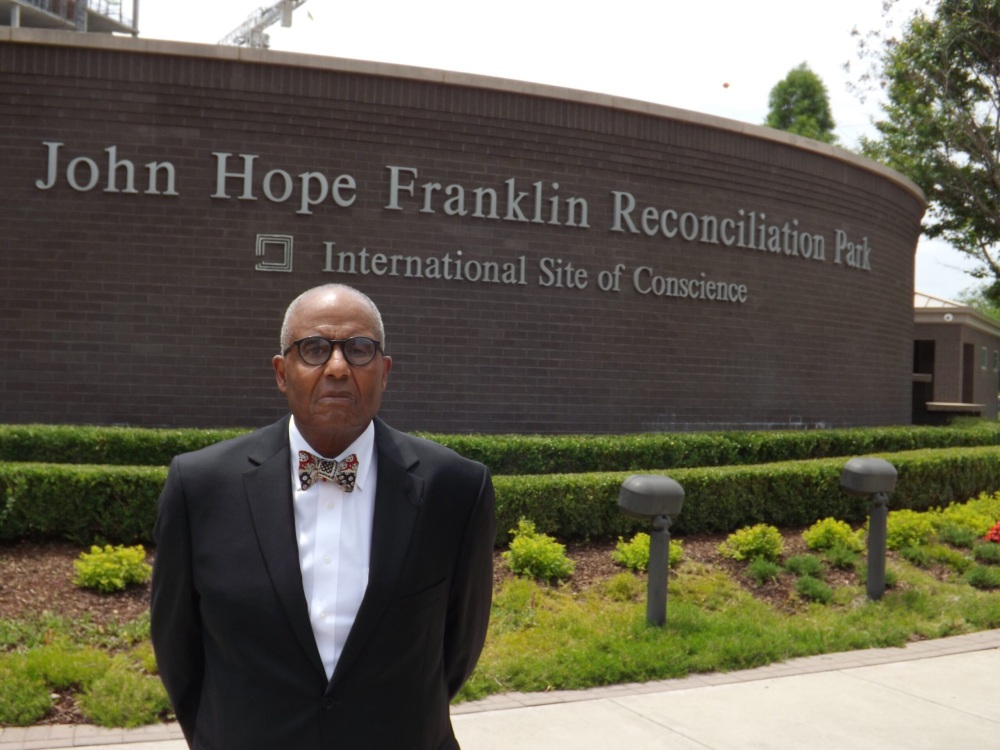

To honor the 100-year mark since the Tulsa Race Massacre, U.S. Semiquincentennial Commissioner Noah Griffin visited the site of one of the single worst incidents of racial violence in American history. Below is the reprint of his column, which originally appeared in the Marin Independent Journal on June 5, 2021. It was just days after he attended commemoration events and a memorial in the historic Greenwood District, formerly known as “Black Wall Street,” which was burned to the ground by white residents over the course of two days from May 31 through June 1 in 1921.
Marin Voice: Tulsa Race Massacre commemoration an eye-opening trip back in time
Being in Tulsa, Oklahoma to commemorate the 100th anniversary of the Race Massacre of 1921 made me think of the 1950s TV program “You Are There.”
Hosted by Walter Cronkite, the newsman donned modern attire to travel “back in time” for interviews of key figures amid a historically recreated event.
Were he to have returned to 1921 Tulsa, he would have interviewed J.B. Stradford, owner of the Stradford Hotel.
“Did you anticipate anything like this could happen in Tulsa?” Cronkite would have asked.
“No, not really,” an actor playing Stradford might have answered.
“I thought race relations here were fine. So I built this six-story hotel, the grandest in the nation for Black folks to stay. It was in Greenwood, our part of town. My story was living testimony to what hard work and industry could accomplish, even in the segregated Midwest.”
Cronkite would move to the next figure.
“Please step up to the microphone Mrs. Loula Williams. You and your husband built two movie theaters in town. What do you make of the massacre?”
“It saddens me,” Williams might have said. “We represented a normal way of life. They could sit anywhere in the theater. We showed the films of Oscar Micheaux, one of the early Black filmmakers. We could see ourselves in starring roles, not just maids and butlers.”
As Cronkite moved down the street, he might have approached attorney B.C. Franklin.
“You witnessed the wanton shooting down of Black people in the streets, the destruction of 35 blocks and 1,200 residents. Ten thousand rendered homeless. Overnight, churches, newspaper offices, restaurants, photography studios and a hospital all went up in smoke.”
Franklin might say: “I felt like Pliny the Younger chronicling the burning of Pompey. Unfortunately, that story was buried until centuries later. I hope it doesn’t take that long for people to appreciate the enormity of what occurred here.”
Wendell Phillips, the 19th-century golden trumpet of abolitionism, spoke of Toussaint L’Ouverture, the liberator of Haiti as a forgotten hero. Yet, he predicted 50 years hence when the truth got a hearing, what he accomplished would rise above those of his peers.
It has taken 100 years for the truth of what occurred in Tulsa to be known — let alone the courageous acts of those who fought off the mob.
Last week, the president of the United States came to commemorate the tragedy. Civil Rights leaders from lawyer Ben Crump and Jesse Jackson, to Rep. Barbara Lee and Rep. Sheila Jackson-Lee paid homage.
TV specials gave a factual account. They are now unearthing the remains of those buried in unmarked mass graves. Now through DNA retrieval, they might determine how many were so interred and who they were.
Tulsa has created a John Hope Franklin Memorial Reconciliation Park. A street named for the noted historian, the son of B.C. Franklin, intersects with Martin Luther King Jr. Way, another unforeseeable sign of progress.
There is still a need to make whole the descendants of those massacre victims. They not only were robbed in many incidents of their ancestor’s lives but of lost generational wealth. What has happened in between then and now? How many other Tulsa Race Massacres were there?
Twenty years ago, the Oklahoma Legislature commissioned a report on what happened in Tulsa with specific recommendations. It is gathering dust, along with promises made at the time of the massacre.
What was promised yesterday must be fulfilled today. I wrote this poem dedicated to 107-year-old massacre survivor Viola Fletcher:
For Tulsa’s Sake: “Bombed from the air / Murdered in the street / Bodies scattered where / In mass graves they meet / Buildings laid bare / Homes, but memory / Fire doesn’t care / Burns incessantly / Why would it take / 100 years to know / For Tulsa’s sake? / Oklahoma’s Show.”